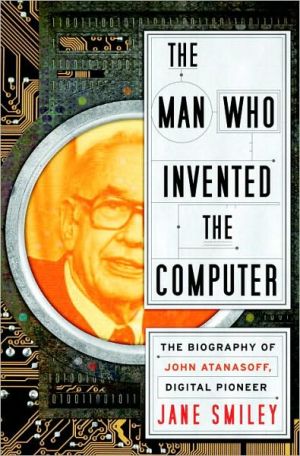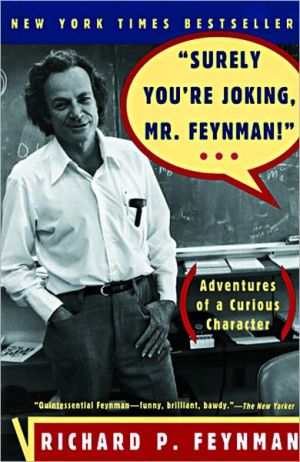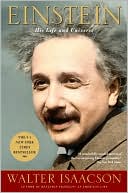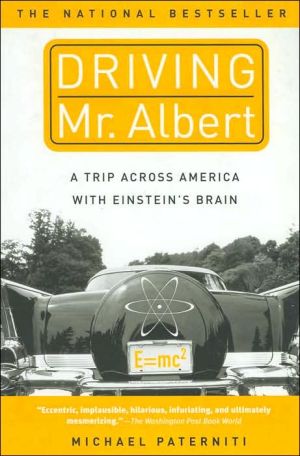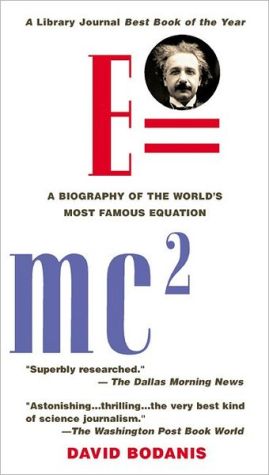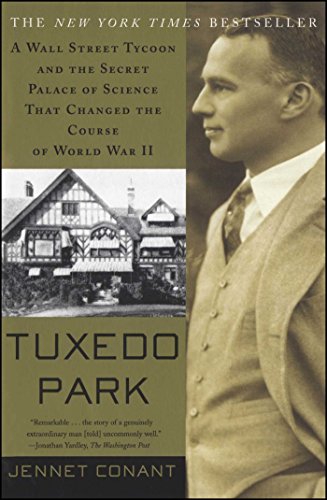The Man Who Invented the Computer: The Biography of John Atanasoff, Digital Pioneer
From one of our most acclaimed novelists, a David-and-Goliath biography for the digital age.\ \ One night in the late 1930s, in a bar on the Illinois–Iowa border, John Vincent Atanasoff, a professor of physics at Iowa State University, after a frustrating day performing tedious mathematical calculations in his lab, hit on the idea that the binary number system and electronic switches, combined with an array of capacitors on a moving drum to serve as memory, could yield a computing...
Search in google:
From one of our most acclaimed novelists, a David-and-Goliath biography for the digital age.One night in the late 1930s, in a bar on the Illinois–Iowa border, John Vincent Atanasoff, a professor of physics at Iowa State University, after a frustrating day performing tedious mathematical calculations in his lab, hit on the idea that the binary number system and electronic switches, combined with an array of capacitors on a moving drum to serve as memory, could yield a computing machine that would make his life and the lives of other similarly burdened scientists easier. Then he went back and built the machine. It worked. The whole world changed. Why don’t we know the name of John Atanasoff as well as we know those of Alan Turing and John von Neumann? Because he never patented the device, and because the developers of the far-better-known ENIAC almost certainly stole critical ideas from him. But in 1973 a court declared that the patent on that Sperry Rand device was invalid, opening the intellectual property gates to the computer revolution. Jane Smiley tells the quintessentially American story of the child of immigrants John Atanasoff with technical clarity and narrative drive, making the race to develop digital computing as gripping as a real-life techno-thriller. The Barnes & Noble Review Smiley blends all these convergent and parallel narratives into a superb whole, as fetching and gripping as any novel. She displays an unwavering, cogent grasp of all the technical details, a keen eye for historical forces, and much psychological insight; her prose is a model of smooth transparency. Anyone who wants to understand the roots of our twenty-first century digital culture needs to read this book.
Chapter One\ John Vincent Atanasoff's father, Ivan, was born in 1876, in the midst of a period of climaxing political unrest. His parents were landed peasants in the Bulgarian village of Boyadzhik (about eighty miles from the Black Sea and perhaps halfway between Istanbul and Sofia). The Ottoman Empire was breaking up--Serbia had won independence in 1830 and Greece in 1832. Revolutionary agitation in Bulgaria, which intensified in the 1870s, culminated in the April Uprising of 1876, in which bands of Christian resistance fighters attacked Ottoman government offices and police enclaves. The attacks were followed by a campaign of reprisal on the part of the Ottoman government. Ivan's father, Atanas, and his mother, Yana, were forced to flee their village, Atanas carrying the baby Ivan in his arms. In the course of the melee, Yana was knocked unconscious and Atanas was shot in the back. The bullet killed Atanas and creased the baby's scalp as it exited through his father's chest, but Ivan and Yana survived (though American translator Eugene Schuyler estimated from his own observations at the time that fifteen thousand Bulgarians were killed, and five monasteries and fifty-eight villages--including Boyadzhik--were destroyed in these attacks). The revolution was put down for the time being and the Ottoman response was widely publicized and deplored, and then in mid-1877, Russia attacked the Ottoman Empire in the Balkans with the express purpose of liberating the Balkan Christian states and regaining access to the Black Sea that Russia had lost in the Crimean War. The conflict was short--the autonomy of Bulgaria was recognized in the Treaty of San Stefano, signed on March 3, 1878. Among the Russian cheerleaders for the war were Ivan Turgenev, who thought Bulgaria should be liberated, and Fyodor Dostoyevsky, who hoped to unite all Eastern Orthodox churches under the Russian church.\ Yana subsequently married a local cattle breeder who could afford to educate little Ivan, while her brother made contact with American missionaries, who helped him get to America. When this uncle returned on a visit to Bulgaria in the late 1880s, young Ivan, now thirteen, decided to go back to America with him. Yana financed the trip by selling a piece of land that Atanas had left her.\ At Ellis Island, Ivan Atanasov's name was changed to John Atanasoff. Although he had a bit of money, it was only enough to rent a room in New York City so that he could work at a series of menial restaurant and handyman jobs while he improved his English. Life was difficult and jobs were scarce, though he did manage to keep a chicken in his room for a while. A charitable local minister he met through his uncle found him a place as a student at the prestigious Peddie School, in Hightstown, New Jersey (not far from Princeton), where he worked hard and did well, but upon graduation, his education at first seemed to be of little use--his uncle had returned to Bulgaria, and there were no more family funds forthcoming. He was homeless for a while, working temporary jobs, but then he related his tale to a Baptist minister named Cooke, who encouraged him to seek the aid of various local congregations. Once he had accumulated $200 in savings and gifts, Pastor Cooke helped him find a spot at Colgate, at that time a Baptist-affiliated college.\ At Colgate, John met the sister of two brothers who were fellow students, a girl named Iva Purdy, a descendant of early settlers in Connecticut and generations of farmers in upstate New York. Iva, herself a high school graduate with a talent for mathematics, was teaching in a nearby school. After courting Iva, John married her at Christmas 1900 and then graduated from Colgate the following June. John Vincent was born on October 4, 1903.\ Although John had taken his degree in philosophy, he found work in industrial engineering at the Edison power plant in Orange, New Jersey. When work at the plant (possibly chemicals used in the manufacture of lightbulbs) seemed to be adversely affecting his health, he moved on to the power plant in Utica, New York, then to the Delaware, Lackawanna, and Western Railroad electrical plant in Hoboken, New Jersey. At night, he took correspondence courses in electrical engineering. Four children had been born by the time John Vincent was nine--two who lived and two who died in infancy. John and Iva came to feel that the family was not thriving because, in addition to John's own respiratory problems, the children were suffering repeated bouts of illness. They decided to move to the newly founded town of Brewster, Florida, on the west coast, some thirty miles as the crow flies southeast of Tampa, where American Cyanamid was in the process of exploiting local phosphate deposits. John got a good job, and the children's health improved. John Vincent attended school at the local two-room schoolhouse.\ Iva Atanasoff gave her oldest child considerable freedom, both of action and of thought, in part because other children were born in Florida (eventually there were seven) and she oversaw a large garden in addition to the household. But Iva also retained her interest in intellectual pursuits--according to family stories, she liked to sit in her rocking chair and read while John and his younger brothers and sisters played about her. By the time young John got to school, he already knew how to read and calculate, and at first he was a difficult pupil--he was used to following his own agenda. Since he had no trouble doing his work, he finished ahead of the other children, and once he had done so, he made himself a "pest," according to his younger sister. But he was an inconvenient pupil also because he was inquisitive and knew more than many of his teachers. He was easily offended, especially by teasing and slurs, and he didn't mind getting into fights. Some teachers handled him well and some did not, but however they handled him, his pronounced eagerness to learn persisted--he eagerly explored both the countryside and whatever books he could get hold of.\ In 1913, when he was not quite ten, John helped his father wire their home for electricity (subsequently, they wired the homes of some of their neighbors, too). In 1914, John mastered the owner's manual of his father's new Ford Model T, and at eleven he was driving it. John read his mother's books, including Ruskin and Spenser, and he read his father's books--including a manual on radiotelephony (wireless sound transmission). When his father ordered an up-to-date slide rule, then decided that he didn't really need it, John mastered it within a couple of weeks and thereupon became, in his own mind, a nascent mathematician. He found his father's old college algebra textbook and began to work his way through it. What he could not understand (differential calculus, infinite series, logarithms) Iva explained to him. During this period, he learned about various number systems other than the decimal system--this unusual familiarity with nondecimal ways of counting and calculating and his practice using them was what would eventually distinguish his ideas about calculators from those of his contemporaries.\ John liked to make things and to demonstrate his skills--in sixth grade, because some older girls who had already finished elementary school were gathering in the back of the classroom and crocheting, he learned to crochet. He pursued his project at school, no longer undaunted by teasing but stimulated by it--he flaunted his work and bragged about his skills until the teacher banned crocheting at school. He soon learned to sew. In fact, John Vincent Atanasoff seemed to see every new idea or object as an opportunity to explore and master whatever his world had to offer. Atanasoff's parents gave him plenty of freedom, encouraged his enterprise, and helped him pursue what he wanted to master. They also made a stable life for him in an out-of-the-way spot where there was plenty to do and plenty of space to do it in.\ The Atanasoffs' life in Brewster was not untroubled--the Atanasoff family, with its strange name and alien ways, was sometimes harassed and their property vandalized. John Atanasoff encountered resentment at work. The larger culture seethed with prejudice and vigilantism. A local Catholic lawyer was run out of the area. Between 1909, when the Atanasoffs arrived in Brewster, and 1920, more than fifty black people were lynched in Florida--Atanasoff himself remembered witnessing a lynching as a teenager, in Mulberry (about eleven miles north of Brewster), though that one is not attested to in Ralph Ginzburg's 100 Years of Lynchings.\ In 1912, John and Iva purchased a 155-acre farm southwest of Brewster, which included a 30-acre orange grove and 120 acres of timber. For young John, the farm meant more scope for exploration and, in particular, endless chances to not only repair the machinery used on the farm, but to take it apart and improve its design. The boy became interested in farming itself--he subscribed to Wallaces' Farmer (the publication founded in Iowa by the grandfather of Vice President Henry A. Wallace) and tried the latest farming techniques. Since John Atanasoff worked full time, young John became the one who organized and ran the farm. In the meantime, he graduated from the high school in Mulberry, completing his coursework in two years, at fifteen. The teachers at the high school did not attempt to control Atanasoff's independence or restrict his education--they encouraged his curiosity and his enterprise. Once he had graduated, Atanasoff got himself certified to teach math classes and saved the money he earned toward his college education, which he already knew would be in math and science. He worked for a year as a phosphate prospector and entered the University of Florida in 1921, just before his eighteenth birthday.\ The University of Florida is and was a land-grant university. The Morrill Act of 1862, under which both the University of Florida and Iowa State College were founded, was written for a specific educational purpose: "to teach such branches of learning as are related to agriculture and the mechanic arts, in such manner as the legislatures of the States may respectively prescribe, in order to promote the liberal and practical education of the industrial classes in the several pursuits and professions in life." In other words, the land-grant colleges were intended to focus on the useful. In what is perhaps the paradigm of public higher education, the three state-funded colleges in Iowa are an example of this idea of the distinct (and class-based) purposes of higher education: postgraduate degrees are offered by the medical school, the art school, the music school, the graduate school, the law school, and the business school at the University of Iowa. Postgraduate degrees in engineering, agriculture, veterinary medicine, design, and industrial engineering are offered at Iowa State (though these categories have gotten somewhat less distinct in the last twenty-five years). The third state-funded school was, until 1961, Iowa State Teachers College, a normal school. Although the system of higher education was not as distinct in every state as it was in Iowa (the University of Wisconsin and the University of Minnesota have all types of programs on the same campus), the land-grant colleges retained their focus on disciplines applicable to the health and wealth of the individual states. The Morrill Act promised to fund these colleges by granting each state thirty thousand acres of federal land, the proceeds of which would go to the colleges. The land did not have to be inside the state--New York State was granted land in Wisconsin, for example.\ The Morrill Act did not originally cover Florida, because the Confederate states had seceded from the Union before the passage of the act, but the act was extended in 1890 to the former Confederate states. Most of these states used money from the act to fund the useful arts at the main campus and to fund the establishment of separate, segregated black colleges. In 1905, Florida Agricultural College, in Lake City, was moved fifty miles south to Gainesville and renamed the University of the State of Florida. At the time of John Vincent Atanasoff's matriculation, the university was all male and all white--women students went to Florida Female College, in Tallahassee, and black students of both sexes went to Florida Agricultural and Mechanical College for Negroes, also in Tallahassee. Related to the Morrill Acts of 1862 and 1890 was the Hatch Act of 1887, which funded (also through land grants) the establishment of agricultural experiment stations in each of the states. These stations were normally attached to the land-grant colleges, broadening their practical mandate.\ By the time he began college, Atanasoff knew he wanted to study physics and to be a physicist. He was familiar with and excited by Einstein's theories and by the other work being done in the field, but no physics major was offered at the university, so he went into electrical engineering, the most theoretical scientific major offered. In Gainesville, Atanasoff was surrounded by opportunities to think, but also opportunities to do. Requirements of the electrical engineering major included building models and projects, so Atanasoff took classes in machine shop, forge and foundry, and electrical mechanics. He also pursued his earlier interest in radio communication. He tutored students for money and worked summers--one summer in Jacksonville, he found a lucrative job surveying the city streets. He was, in short, brilliant, eager, enterprising, highly directed, and hardworking. Just as John Atanasoff's life had been almost a paradigm of the classic immigrant story, John Vincent Atanasoff's life was almost a paradigm of the classic ambitious American tale--a Tom Sawyer-like boyhood followed by a Horatio Alger-style self-funded and successful career.\ But the elder Atanasoff's life remained difficult--while John Vincent was away in Gainesville, John and Iva decided to sell the farm and move to Bradley Junction, a town between Brewster and Mulberry. One night when John was coming home, he was attacked by a mob clad in white robes and nearly killed. He was saved by the wife of the Cyanamid plant manager, who heard the ruckus and ran outside with a shotgun. The mob was revealed to be made up, in part, of neighbors whose children Iva tutored in math and, in part, men who worked for John at the plant, all apparently motivated by the strangeness of John's name and origins. The attackers broke John's leg and ribs, and there were so many internal injuries that John was bedridden for weeks; John Vincent had to return from college to help take care of him. Although the attack was foiled, the younger Atanasoff children suffered for years from the xenophobia, and probably the envy, of the local population.
\ From Barnes & NobleIf you experienced a double-take when your eyes reached the author's name, award yourself ten points for knowing that Jane Smiley is a Pulitzer Prize-winning novelist. If you recognized the name of John Atanasoff, give yourself a hundred points, and that, in a sense is the point of this book: Iowa State University physics professor John Vincent Atanasoff (1903-1995) remains an almost totally unknown pioneer of the digital age and therein lies Smiley's tale. It was in a small-town bar in the late 1930s that the electrical engineer son of an Bulgarian immigrant father hit on the ingenious idea that the binary number system, electronic switches, and capacitors mounted on a moving drum could transform mathematical calculations. His prescient insights were, unfortunately, not patented, but time, as Smiley artfully explains, eventually corrected that oversight. A fascinating crossover read about one man's greatest brainstorms.\ \ \ \ \ \ Publishers WeeklyNovelist Smiley explores the story of the now mostly forgotten Atanasoff, a brilliant and engaged physicist and engineer who first dreamed of and built a computational machine that was the prototype for the computer. With her dazzling storytelling, Smiley narrates the tale of a driven young Iowa State University physics professor searching for a way to improve the speed and accuracy of mathematical calculations. In 1936, Atanasoff and his colleague, A.E. Brandt, modified an IBM tabulator--which used punched cards to add or subtract values represented by the holes in the cards--to get it to perform in a better, faster, and more accurate way. One December evening in 1937, Atanasoff, still struggling to hit upon a formula that would allow a machine to replicate the human brain, drove from Ames, Iowa, to Rock Island, Ill., where, over a bourbon and soda in a roadside tavern, he sketched his ideas for a machine that would become the computer. As with many scientific discoveries or inventions, however, the original genius behind the innovation is often obscured by later, more aggressive, and savvy scientists who covet the honor for themselves. Smiley weaves the stories of other claimants to the computer throne (Turing and von Neumann, among others) into Atanasoff's narrative, throwing into relief his own achievements. (Oct.)\ \ \ Kirkus ReviewsPulitzer Prize–winning novelist Smiley (Private Life, 2010, etc.) looks at the curious personalities and tortured paths that led to the first computer(s).\ As in her novels, the author displays a talent for keeping a dozen fully realized characters on stage. While John Atanasoff is certainly a likely candidate for "the man who invented the computer," plenty of strange, captivating people were concurrently at play in the same field. "The story of the invention of the computer," writes Smiley, "is a story of how a general need is met by idiosyncratic minds, a story of how a thing that exists is a thing that could have easily existed in another way, or, indeed, not existed at all." But it did exist, and in permutations galore, the brainchildren of a host of atypical men: geniuses, cranks, the impossibly remote, the backroom dealer. The author provides vivid characterizations of each: Atanasoff, enterprising, hardworking and so highly directed that he could have been an Asperger's candidate; Alan Turing, a computer visionary who couldn't build a birdhouse; Konrad Zuse, a German reduced to scavenging pieces of material for his machine from the bombed-out streets of Berlin "without getting shot for looting"; John von Neumann, who contributed important architectural features to computer design and whose upper-class connections allowed him great freedom. Smiley captures the men in their evolving milieus—at universities and in war rooms and business offices—and notes that they sometimes came into contact. One example was the meeting between Atanasoff and John Mauchly, another computer designer, a brief encounter in which Atanasoff revealed the workings of his machine, and ultimately led to the patent case that was found in Atanasoff's favor as the inventor of the first "automatic electronic digital computer for solving large systems of simultaneous linear equations."\ Engrossing. Smiley takes science history and injects it with a touch of noir and an exciting clash of vanities.\ \ \ \ \ \ The Barnes & Noble ReviewFrom Paul Di Filippo's "THE SPECULATOR" column on The Barnes & Noble Review\ The entire Internet, as well as the types of devices represented by the desktop computer, the laptop computer, the iPhone, the iPod, and the iPad, are a continuing inescapable embarrassment to science fiction, and an object lesson in the fallibility of genre writers and their vaunted predictive abilities. (Yes, yes, we all know that "SF is not about predicting things." But have you ever seen any writer turn down credit when they do hit the fortune-telling bullseye?)\ Hardly a single story in the genre prior to, oh, say, 1970, exhibited an accurate handle on computers. As a rule, there were no far-sighted, speculative depictions of the devices' miniaturization, ubiquity, influence, and utility that would prefigure the landscape of 2010 as we know it. Oh, sure, you can point to a few isolated instances of authors writing on the digital cutting edge. One example that is trotted out regularly, like a token Cassandra-accurate economist amidst boom-inflating hedge fund managers, is Murray Leinster and his story, "A Logic Named Joe," from 1946:\ \ You got a logic in your house. It looks like a vision receiver used to, only it's got keys instead of dials and you punch the keys for what you wanna get. It's hooked in to the tank, which has the Carson Circuit all fixed up with relays. Say you punch "Station SNAFU" on your logic. Relays in the tank take over an' whatever vision-program SNAFU is telecastin' comes on your logic's screen. Or you punch "Sally Hancock's Phone" an' the screen blinks an' sputters an' you're hooked up with the logic in her house an' if somebody answers you got a vision-phone connection. But besides that, if you punch for the weather forecast or who won today's race at Hialeah or who was mistress of the White House durin' Garfield's administration or what is PDQ and R sellin' for today, that comes on the screen too. The relays in the tank do it. The tank is a big buildin' full of all the facts in creation an' all the recorded telecasts that ever was made -- an' it's hooked in with all the other tanks all over the country -- an' everything you wanna know or see or hear, you punch for it an' you get it. Very convenient. Also it does math for you, an' keeps books, an' acts as consultin' chemist, physicist, astronomer, an' tea-leaf reader, with a "Advice to the Lovelorn" thrown in.\ \ But for every Leinster there were a thousand other writers with their heads buried in the sand, such as the otherwise on-target Robert Heinlein, and his character Andrew Jackson "Slipstick" Libby, famed mathematical genius who helped pilot starships -- with his slide rule! \ It was not until the appearance of cyberpunk in the 1980s that SF began to grapple in a broadly meaningful way with the reality of computers as something other than giant mainframes tended by crewcut IBM nerds. But the irony -- and the point of the aforementioned lesson -- is that the information about the potential paradigm-shattering role that computers might play in society was extant as early as the late 1930s, coincident with the birthpangs of actual computers.\ Admittedly, it wasn't headline material in the daily newspapers. But any SF writer of that era -- and of subsequent decades -- with the willingness to dig into the scientific and industrial and military journals would have found a rich vein of extrapolative material that would have allowed a more sharp-eyed assessment of where computers might be heading. While there were indeed secrets involved in early computer technology that would not emerge for decades, the suggestive, extendable mainline of the technological arc was there for the winkling-out. Had SF authors of the period been inclined to investigate, the whole course of the genre would have been altered. But, just as today, commercial regurgitation of received ideas trumped pioneering ideation based on hard facts.\ What exactly were the public details surrounding the invention of the modern computer? Thanks to author Jane Smiley, best known for such literary excursions as her Pulitzer-winning novel A Thousand Acres, we can now get a comprehensive overview of that exciting period through her newest book, The Man Who Invented the Computer. She follows the John McPhee-perfected recipe for historical journalism nicely and with élan: take an abstruse subject, research it deeply, then humanize it tenderly, adding off-kilter insights and sharp portraits of the curious folks involved.\ Smiley's book is subtitled "The Biography of John Atanasoff, Digital Pioneer." And while the named subject does indeed occupy center stage, the narrative covers so much more ground than one man's life, from the early years of the twentieth century (Atanasoff's youth) up to a pivotal court decision in 1973. As Smiley says in her introduction, the book is like four movies playing simultaneously.\ First come the character portrait and career outline of Atanasoff, a cornfed Edison of sorts. It's a tale out of Sinclair Lewis, as if replayed by Hugo Gernsback. We see the forces that shaped young Atanasoff, his remarkable epiphany in 1937 that led to the construction of the first workable, practical electronic computer. We follow his retreat from the field, his long hegira in other realms of expertise, and his eventual return in the 1960s to claim his proper credit.\ The second narrative is a fairly well-known one, involving Alan Turing, the superstar of the field. Smiley, nodding to the familiarity of Turing's life, gives him just enough coverage to place him in context. Here we have something out of Eric Ambler or John Buchan. But the third strand is definitely the weirdest. It's the saga of Konrad Zuse, an isolated, eccentric German trying to invent a computer out of junk parts prior to and during WWII. This bit reminds me of Gravity's Rainbow, and I kept waiting for Tyrone Slothrop to appear around every bend of the subplot.\ Lastly we get what might be termed the "institutional/big business" side of the tale. Inventors Mauchly and Eckert, having ripped off Atanasoff, produce ENIAC and other computing machines, with the help of the military, corporations, and famous scientists such as John von Neumann, opening the floodgates for a million digital flowers to bloom, until a major trial in the late 1960s restores Atanasoff's honor and precedence. This segment might have been authored by Norman Mailer handing off to John Grisham.\ Smiley blends all these convergent and parallel narratives into a superb whole, as fetching and gripping as any novel. She displays an unwavering, cogent grasp of all the technical details, a keen eye for historical forces, and much psychological insight; her prose is a model of smooth transparency. Anyone who wants to understand the roots of our twenty-first century digital culture needs to read this book.\ But if science fiction's track record for predicting the computer's path to world domination is a poor one, that doesn't mean the genre isn't catching on. To see how computers are being portrayed in near-future scenarios, it's worth having a look at Robert Sawyer's WWW: Watch, a sequel to WWW: Wake.\ Sawyer's earlier book introduced us to teenaged heroine Caitlin Decter, whose blindness is being treated by an experimental new technology that inadvertently puts her in communication with the rudimentary but evolving intelligence bootstrapping itself out of the worldwide web. She dubs it Webmind, and a strange friendship is begun.\ The notion of an autonomous cybermind arising spontaneously as an emergent property of complexly networked systems is hardly new. Perhaps the first full instantiation of the trope occurred in Heinlein's The Moon Is a Harsh Mistress (thereby restoring to the Grand Master some of the speculative street cred he lost with "Slipstick" Libby). Curiously enough, the same year we got the Heinlien novel, we also received D. F. Jones's Colossus, which employed the same concept. After that watershed the trope was firmly in place, surfacing at regular intervals, with one other notable early instance being David Gerrold's When HARLIE Was One. Nowadays, when such a concept is invoked, it's usually tied to the notion of the "Singularity" (the postulated moment when the distinction between human and machine minds will vanish) and posthumanism, a route Sawyer seems disinclined to follow, hewing to more old-fashioned developments.\ Sawyer has never been a flashy or far-out writer. No transcendent leaps or gonzo forays into SF surrealism for him. His preferred mode is methodical, step-by-step unfolding of a solid idea, with verisimilitude given a priority. Consequently, much of the first two volumes of this projected trilogy will strike more seasoned readers of the genre as highly familiar and unadventurous. I suspect that even those whose acquaintance with SF is limited to first-generation Star Trek reruns will not have their minds blown.\ But on the other hand, Sawyer's cautious, slow approach, homely details, and plain-spoken prose succeed in creating an introductory-level text that has the virtue of making the whole concept of machine intelligence seem highly probable and comprehensible. Writing alternate passages in the voice of Webmind, Sawyer crafts a sincere portrait of non-human intelligence and perceptions, developing alongside his likeable human human characters. Caitlin and Webmind mature and evolve in parallel, illustrating both the differences and consanguinity of the two classes of intelligence and self, organic and electronic.\ Sawyer's book is low on action sequences. A bit of thriller-style suspense comes from the presence of WATCH, a government agency charged with monitoring suspicious doings on the Internet. They naturally become aware of Webmind, with predictable hostile reactions. But the conflict embodied in their response is outweighed by the discursiveness of the rest of the story. In true Asimovian fashion, the play of ideas as they emerge in rational conversation forms the real excitement for Sawyer. The reader will exit this novel feeling that the computer -- a gadget so fortuitously and aleatorily invented, as Smiley shows us -- was somehow predestined to emerge as mankind's true companion.\ \ \ \ \ \
